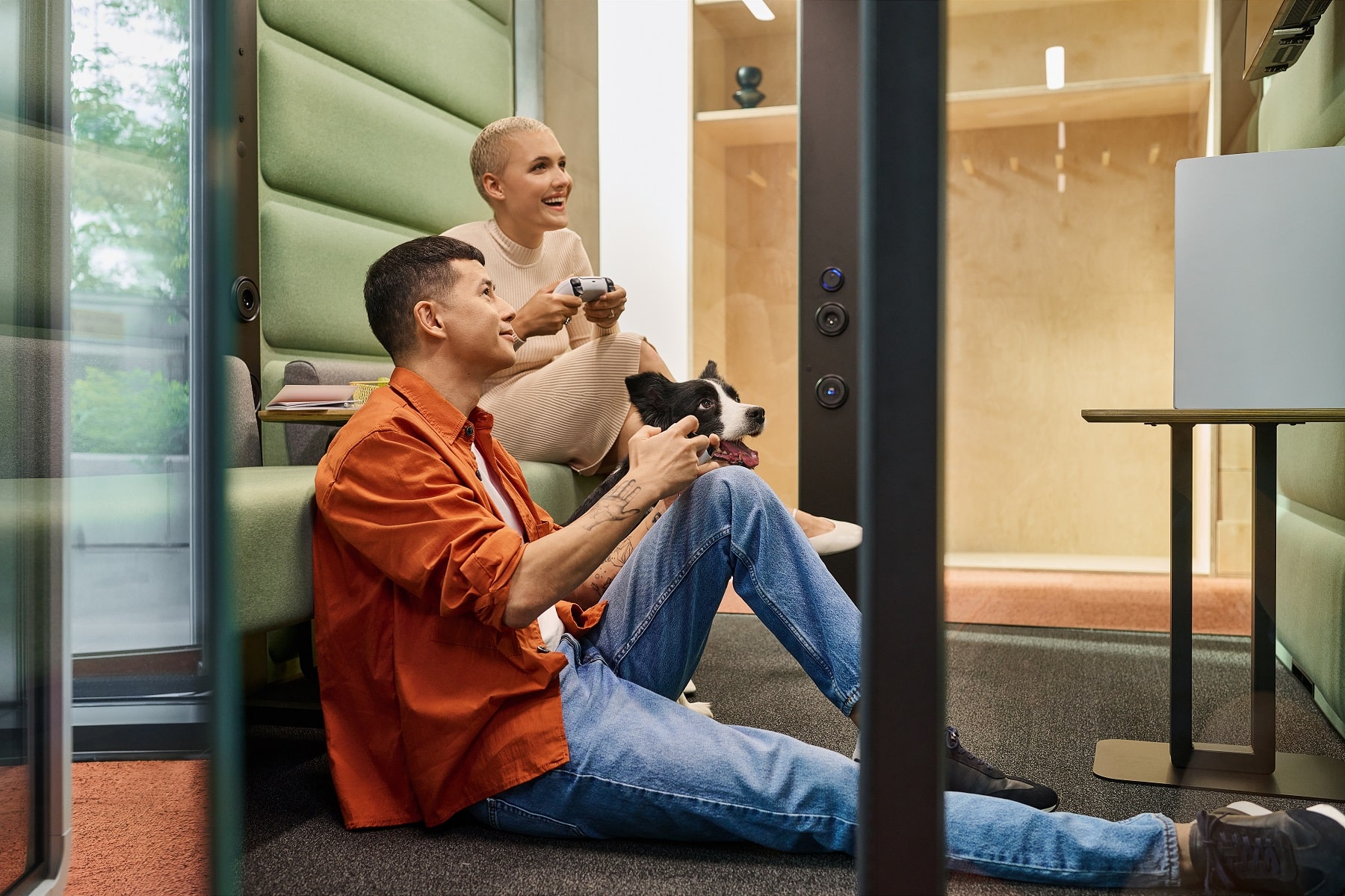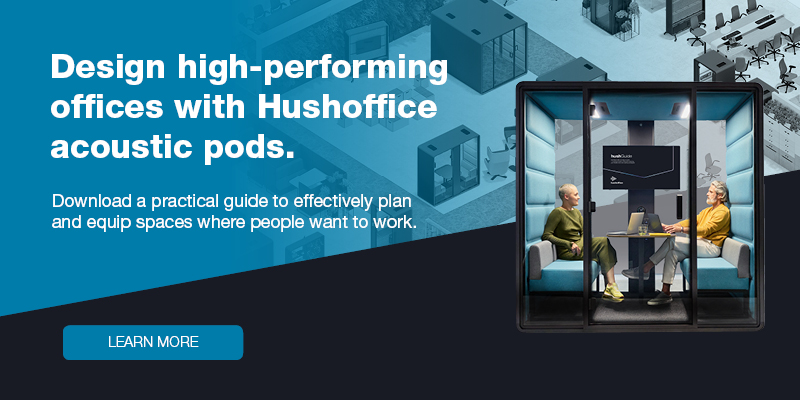Pet-friendly workspaces offer numerous advantages
- Posted on: 13 March 2024
- By: Hushoffice Team
The celebration of National Puppy Day falling on 23rd March is a great opportunity to present the many benefits that animal-friendly offices offer, including minimising stress, creating a positive atmosphere, improving team dynamics, or enhancing employee productivity. And there’s more. Let’s have a look.
Pet-friendly office – tl;dr
In animal-friendly workspaces, a staggering 91% of workers show higher levels of engagement at work, with 67% reporting increased performance. Moreover, 85% of employees claim that absenteeism due to poor well-being is hardly an issue. There is scientific evidence that merely stroking a dog or a cat significantly reduces stress.
If you find it difficult to draw employees back to the office, consider creating an animal-friendly workspace. A remarkable 91% of workers in pet-friendly offices claim that their company fosters healthy work-life balance – a key aspect that employees are afraid of losing upon their return to the office. Indeed, accepting pets may improve the attractiveness of the workspace by providing employees with the opportunity to work with their furry friends on a daily basis.
Although most employees are in favour of allowing pets in the workplace, there are always exceptions to the rule. Some individuals may be allergic to cats and dogs (the problem concerns 10-20% of the global population), others may have no interest in animals at all. That’s why a part of pet-friendly policy in the workplace should be designating animal-free areas in the office, such as hushFree pods. The new line of Hushoffice pods includes hushFree.S office phone booth equipped with a height-adjustable tabletop, 4-person hushFree.M meeting booth, and hushFree.L large pod.
The majority of workers would like to take their pets to work.
94% of employees are in favour of having animals in the office, with 76% saying that it creates a positive atmosphere at work. It makes perfect sense! Most people love animals and appreciate their positive impact on our emotional state and mood.
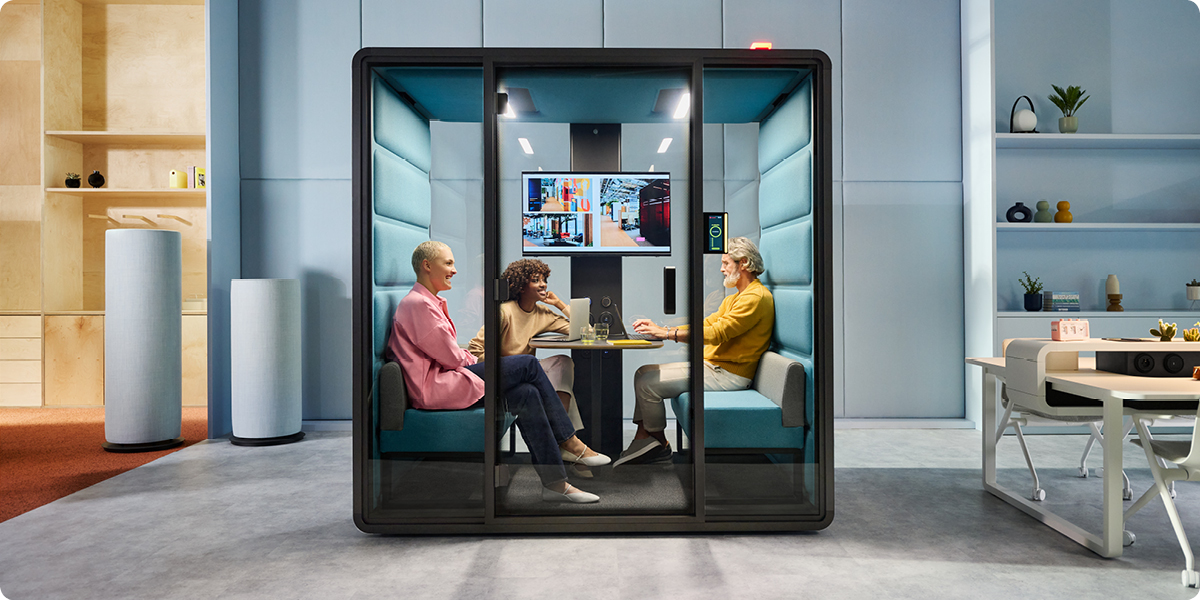
Bringing pets into the workplace can really change the way we feel at work. Interacting with a dog or a cat can contribute to an improved sense of togetherness and friendship. A quick break to cuddle with the fluffy office companion or a walk with a puppy can recharge your batteries and stimulate creativity. Actually, it’s not so much about work. Workers who spend time with their pet during the working hours feel more satisfied and engaged. In fact, clients and business partners appreciate it as well. The point is that pets add a warm, inviting quality to the workspace, turning meetings into unforgettable talks over a wagging tail or a soothing purr
– says Mateusz Barczyk, Senior Brand Manager, Hushoffice.
There are substantial physical health benefits that result from a pet-friendly office policy.
According to scientific data, interaction with pets enhances our mood, reduces stress levels, provides companionship, boosts our life quality, increases oxytocin levels, lowers our blood pressure, and reduces the risk of a heart attack. You should definitely think about dogs as man’s best friends!
Walking the dog might be an ideal movement break as periodic breaks enhance productivity.
As physical activity is inherent in pet ownership, dog owners are 34% more likely to achieve the recommended goal of 150 walking minutes per week compared to individuals who don’t own a dog. And a walk with your dog has a twofold function: it enhances your cardiovascular health, reduces blood pressure and enables you to take a relaxing nature break. So, it’s a perfect work break both for your body and mind.
Find out more about the significance of work breaks: Give me a microbreak!
You think pets are distracting? Quite the contrary. Contact with animals can boost employee performance.
Individuals taking their dogs to work report a 33% improved concentration in their workplace and a 16% boost in commitment. These data prove that animals in the workspace can boost employee engagement, which is a primary driver of business results.
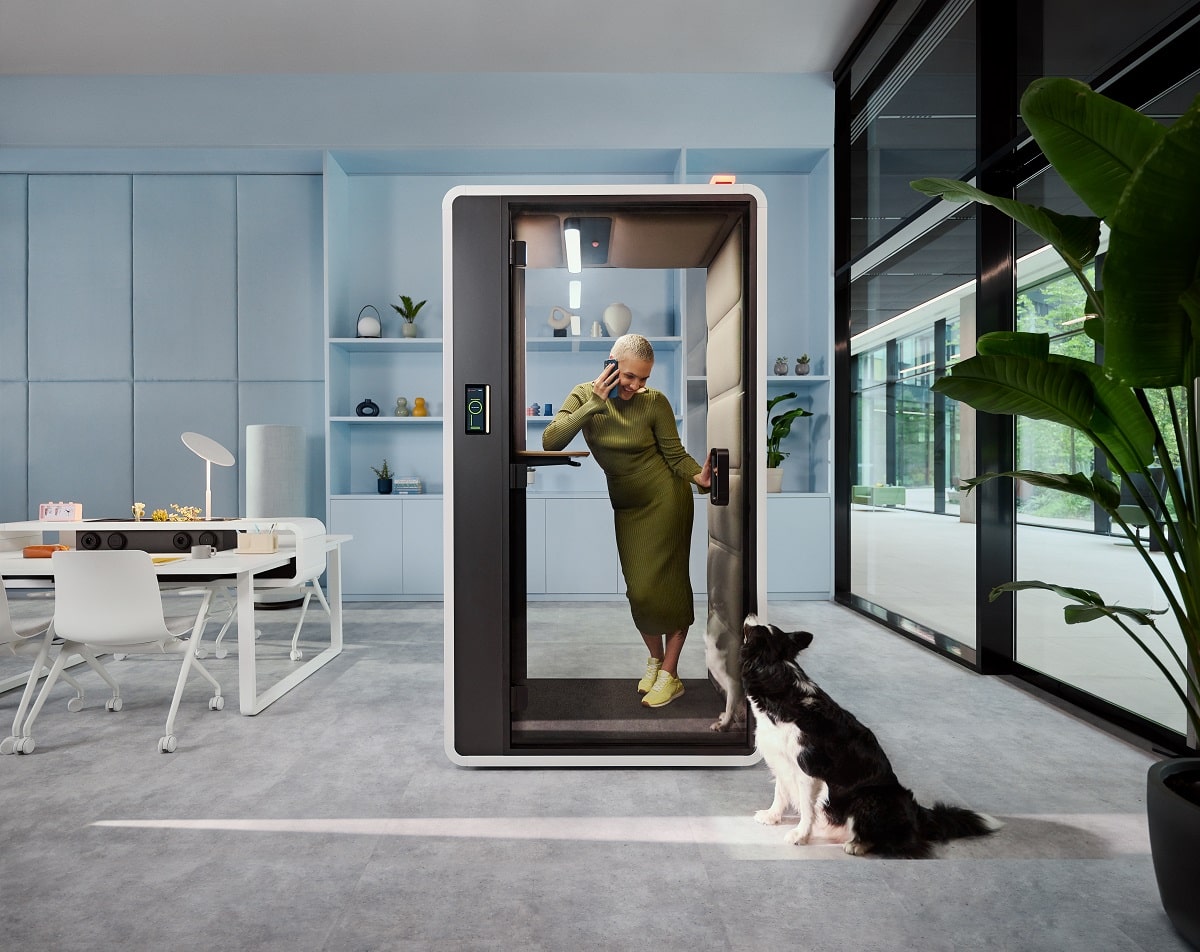
67% of employees working in animal-friendly workspaces report enhanced productivity.
The statistics consistently prove that allowing pets in the workspace is a relatively simple way to enhance company performance. And it can be achieved without making additional investments in spatial solutions or introducing modifications to the company policy. Truly, research conducted by the University of Lincoln has shown that workers who frequently take their dogs to work are 22% more satisfied with their working environment
– explains Mateusz Barczyk, Senior Brand Manager, Hushoffice.
According to studies at Washington State University, being engaged with dogs considerably enhances our executive function, which is responsible for our ability to think, concentrate, and plan. Interestingly, this positive effect was still visible 6 weeks after the interaction with the dog.
Enhanced performance in animal-friendly workspaces can be mostly attributed to engagement. A staggering 91% of workers in pet-friendly plus workspaces report improved work engagement, compared to 65% in offices that don’t have animal-friendly policies.
In general, pet ownership is linked to improved verbal memory and fluency. If having a dog or a cat has such clear advantages, it might be a good idea to incorporate their positive influence into the office.
Pets reduce stress levels by introducing joy and presence.
The health-restoring power of pets is strongly supported by studies. In animal-friendly workspaces, absenteeism due to poor well-being is hardly an issue for 85% of individuals, partly because nearly 50% of workers report a more pleasant atmosphere. What’s more, there is scientific evidence that merely stroking a dog or a cat significantly reduces stress levels.
Dog-friendly workspaces attract loyal workers.
66% of HR specialists admit that interviewees ask questions about pets in the workspace. As pet-friendly company policies are relevant for half of workers, animal-friendly perks can encourage candidates to accept a certain job offer. Additionally, 46% of individuals would be more likely to recommend the company if it allowed animals in the workspace.
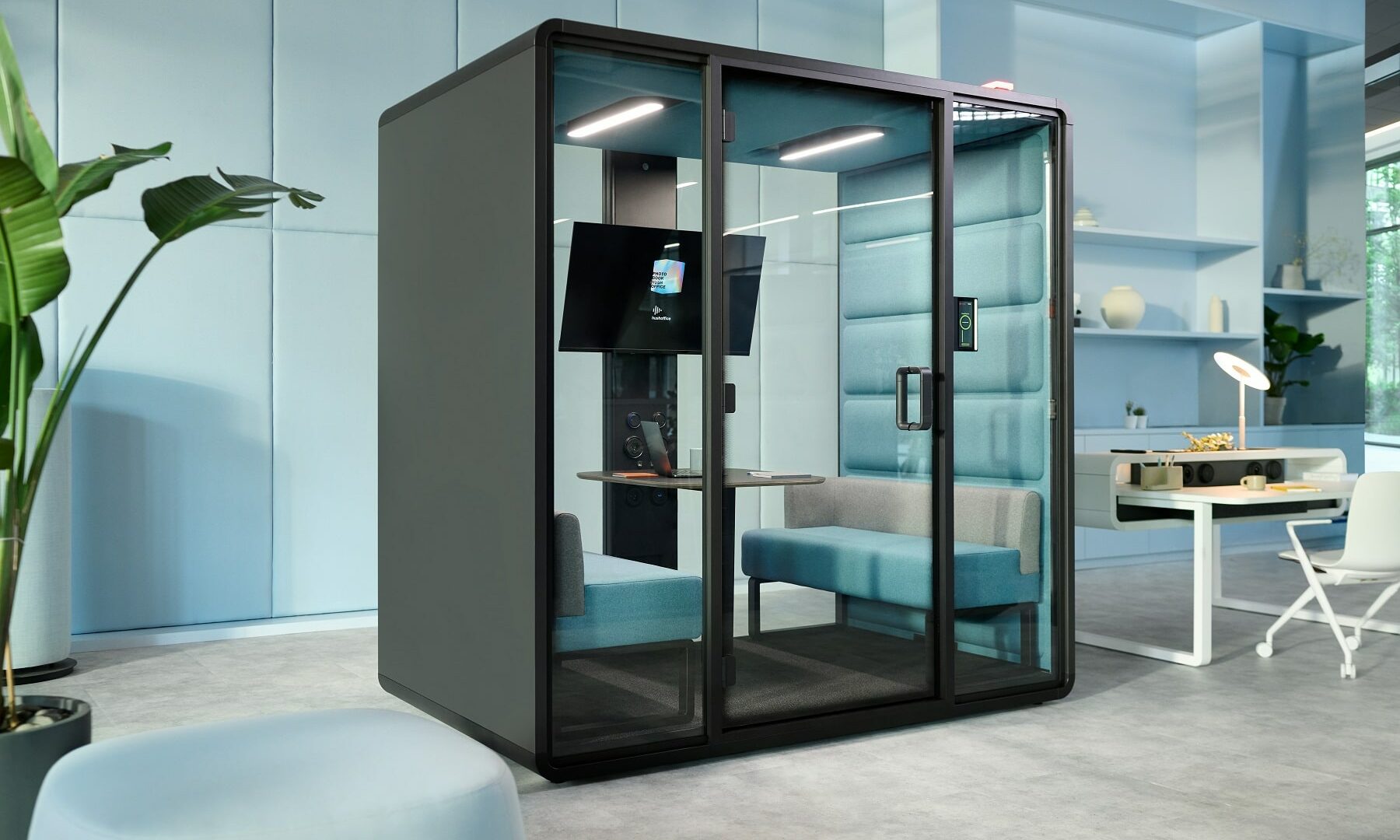
88% of workers in animal-friendly companies intend to stay for a minimum of one year.
Indeed, a whopping 90% of workers in animal-friendly offices feel connected with company values and show real commitment to their work. Thus, they are happy to recommend their employer to others, compared to only 65% of workers in non-animal-friendly offices.
91% of workers in animal-friendly workspaces claim that their company fosters healthy work-life balance.
During the pandemic, 23 million American households decided to get a pet. At present, 67% of pet owners admit they might consider leaving if their company stopped providing remote-work opportunities. On the other hand, 78% of this group might consider staying if they were allowed to take their dog to their workplace.
When it comes to socialisation, animals are facilitators of social interaction in the office.
Most of us can connect with a cute animal. That’s why, in animal-friendly offices workers are 3 times more likely to establish positive relationships. It seems that the presence of dogs in the workspace helps break the ice and encourages people to get to know each other.
The presence of dogs in the workspace brings people together regardless of their post or position in the hierarchy by introducing a common interest fostering organic connection and spontaneous, relaxed interactions. Additionally, taking a short break to play with animals adds variety to the working day. In general, interactions with pets help remove obstacles and strengthen relationships, creating a warm, homely atmosphere. Also, employees are more inclined to treat their coworkers with kindness and empathy when they share a personal connection with them through a pet
– says Mateusz Barczyk, Senior Brand Manager, Hushoffice.
How to establish a successful pet policy. First steps.
To establish a successful animal policy in the office, you should talk to your employees, define the guidelines, screen the animals, and prepare the office for them.
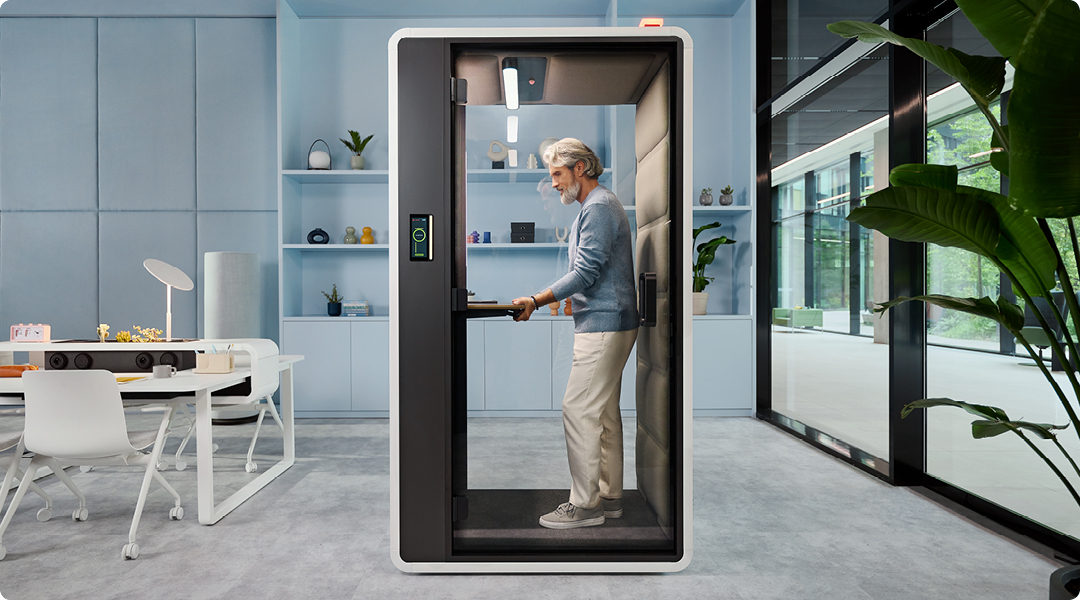
1. Survey your team members.
Allow everyone to have their say on the topic and gather information about allergies and personal dislikes. Opinions and attitudes may differ depending on the generation e.g. millennials are much more likely to support the idea of animal-friendly offices than employees from Generation X and Boomers.
2. Make a draft of a complete policy.
Include detailed information such as allowed breeds, temperaments, and general workspace etiquette. Make sure that all your employees become familiar with the policy and the potential consequences of noncompliance. Additionally, try to predict possible problems such as a pet becoming too distracting.
3. “Vet” out your animals.
You need to make sure that all the pets have the appropriate, sociable temperament to stay in the office all day long. An office pet should be relaxed, friendly to others, and flexible enough to enjoy the experience of a busy workspace.
It may be beneficial to consider some of the following factors recommended by Woofice “Pets in the Workplace” Guide:
- Spayed/neutered
- Current vaccinations
- Devoid of parasites, ticks, and fleas
- No infections or cases of ringworm in the last 6 months
- Microchipped
- House-trained
- Obedient
4. Prepare the office space for pets.
Ensure that all items accessible to dogs or cats are safely stored including rubbish bins, cords, and wires. Also, keep plants, writing accessories, and food out of reach of animals.
Final recommendation: designate animal-free areas in the workspace.
Although the majority of workers appreciate the presence of pets, some suffer from allergies or are simply afraid of animals. That’s why it’s crucial to designate “no animals” areas within the workspace to ensure everyone can enjoy a comfortable working environment.
HushFree pods can be ideal animal-free zones.
Class A work booths from our hushFree collection (such as hushFree.S one-person office pod, hushFree.M meeting booth, and hushFree.L conference booth) make ideal animal-free zones – a necessity in a pet-friendly office. They are private, self-contained spaces equipped with adjustable lights and ventilation systems, offering employees a calm, comfortable, distraction-free working environment within the dynamic, animal-filled workspace.

Pet-friendly office – key takeaways
In animal-friendly workspaces, a staggering 91% of workers show higher levels of engagement at work, with 67% reporting increased performance. Moreover, 85% of employees claim that absenteeism due to poor well-being is hardly an issue. There is scientific evidence that merely stroking a dog or a cat significantly reduces stress.
If you find it difficult to draw employees back to the office, consider creating an animal-friendly workspace. A remarkable 91% of workers in pet-friendly offices claim that their company fosters healthy work-life balance – a key aspect that employees are afraid of losing upon their return to the office. Indeed, accepting pets may improve the attractiveness of the workspace by providing employees with the opportunity to work with their furry friends on a daily basis.
Although most employees are in favour of allowing pets in the workplace, there are always exceptions to the rule. Some individuals may be allergic to cats and dogs (the problem concerns 10-20% of the global population), others may have no interest in animals at all. That’s why a part of pet-friendly policy in the workplace should be designating animal-free areas in the office, such as hushFree pods. The new line of Hushoffice pods includes hushFree.S office phone booth equipped with a height-adjustable tabletop, 4-person hushFree.M meeting booth, and hushFree.L large pod.
Pet-friendly office – frequently asked questions
What are the advantages of a pet-friendly workplace?
First of all, it creates a more positive atmosphere. Contact with animals has been proved to reduce cortisol levels and enhance our mood, helping mitigate stress. What’s more, the presence of pets in the office encourages physical activity in the form of short walks or play breaks, which enhances employee health and wellness. Also, animals have a positive impact on team relationships and communication as shared responsibility for animal care fosters cooperation and rapport building among team members. Last but not least, a pet-friendly workspace is a sign of innovative, employee-centred culture, which may be a relevant factor in attracting and retaining talent.
What makes a successful office animal policy?
First and foremost, you need to lay down clear guidelines concerning the type of animals allowed in the office, including their species and size. Additionally, you need to specify requirements for vaccinations, health checks, and behavioural assessments. Another crucial element of your pet policy is designating animal-friendly zones within the workspace as well as the so-called “no-pet zones”. All pet-care duties including feeding, grooming or waste disposal should be well-defined. Last but not least, it is necessary to discuss liability issues (e.g. potential damage or even injuries that pets may cause) and suggest steps to settle possible conflicts or concerns connected with having pets in the office.
Are there any statistics proving a positive impact of animal-friendly office policies?
Employees who take their dogs to the office report a 33% enhanced engagement in their work and a 16% rise in commitment to their work. 67% of individuals working in animal-friendly workspaces show increased productivity. And workers who bring their dogs to the workplace on a regular basis report a 22% boost in satisfaction with their working environment.
